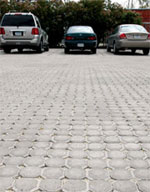 Stormwater runoff is the rainfall or snowmelt that runs off permeable surfaces or impervious surfaces like roads, buildings, sidewalks or compacted ground surfaces.
Stormwater runoff is the rainfall or snowmelt that runs off permeable surfaces or impervious surfaces like roads, buildings, sidewalks or compacted ground surfaces.
Stormwater can flow directly to streams and lakes or it may be transported by municipal storm drain systems. Unlike sanitary sewers, storm drains do not lead to treatment plants, but drain directly into our streams and lakes. According to a six year study conducted by EPA, urban stormwater contains concentrations of pollutants that are equal to or larger than non-urban runoff.
As communities grow, they often experience more stormwater runoff problems due to their increasing impervious surface areas. Rainfall and snowmelt that would normally infiltrate into the soil becomes runoff. This increases both the volume and rate of runoff, which leads to flooding, streambank erosion, and potential damages to public and private property and water quality.
The Iowa Department of Natural Resources is working in a variety of ways to improve stormwater quality. Certain activities and specific municipalities and universities must obtain permits with requirements that are intended to reduce the impact of stormwater on our lakes and streams. In addition, DNR and its partners have developed a number of stormwater "tools" to assist developers, builders, cities and individual Iowans.
Financial Assistance
Iowa Stormwater Management Manual
The Iowa Stormwater Management Manual provides stormwater management strategies that compliment the storm drain network and flood control efforts of the past. The manual provides information on runoff and stream flow changes with urban development, uniform sizing criteria, low impact development alternatives and design guidelines for practices that protect water quality and reduce stream corridor erosion.
A primary focus of the manual is to provide design guidelines for practices that infiltrate small runoff events to protect water quality. The manual also provides design guidelines for stream corridor protection, which is important because stream corridor erosion causes up to 70 percent of sediment loading in urban areas. These practices provide significant water quality benefits, and protect pipelines, sanitary sewers and other infrastructure. Adding water quality and channel protection practices to traditional storm drain network and flood control practices will make our stormwater management strategies more holistic and effective.
Additional Manuals and Brochures
Stormwater Regulations and Permitting
Other Stormwater Resources
DNR Contacts